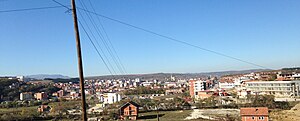Skënderaj
| Skenderaj | |
|---|---|
| Municipality and city | |
|
Serbian: Србица / Srbica Albanian: Skenderaj |
|

Panoramic view of Skenderaj in autumn
|
|
| Location in Kosovo | |
| Coordinates: 42°44′N 20°47′E / 42.733°N 20.783°E | |
| Country | Kosovo |
| District | District of Mitrovica |
| Government | |
| • Mayor | Sami Lushtaku |
| Area | |
| • Municipality and city | 374 km2 (144 sq mi) |
| Elevation | 620 m (2,030 ft) |
| Population (2011) | |
| • Municipality and city | 51,553 |
| • Density | 140/km2 (360/sq mi) |
| • Urban | 10,000 |
| Time zone | CET (UTC+1) |
| • Summer (DST) | CEST (UTC+2) |
| Postal code | 41000 |
| Area code(s) | +383 28 |
| Car plates | 02 |
| Website | Municipality of Skenderaj |
Skenderaj (Albanian: Skënderaj) or Srbica (Serbian: Србица, Srbica) is a city and municipality in the District of Mitrovica of northern Kosovo. It is the largest city in the Drenica region of Kosovo. It is solely populated by Albanians. It is claimed to be the poorest city in Kosovo. It is the place where the Kosovo War began in 1998, and to which the most damage was done.
The settlement is located by the Klina river, in the Klina field (Klinsko polje). It is the main settlement of the Drenica region. The Klina river belongs to the Metohija region, while the settlement morphologically and hydrologically gravitates towards the Kosovo region.
The municipality covers an area of 378 km2, including the town of Skenderaj and 51 villages.
Archaeological findings in the municipality area include a Neolithic site in Rudnik, and remains of a Roman necropolis in Gornji Obilić. The municipality cadastral area includes several settlements that existed during the Middle Ages, among which some exist still today, such as Leočina, Poljance, Banja, and others. There are ruins of a church dating to the 14th century in southern Leočina. The Church of St. Nicholas was built in 1436, in Banja, as the endowment of Serbian magnate Rodop. The Devič monastery was built in Lauša near Srbica in the 15th century, dedicated to the local monk, St. Joanikije (d. 1430). The Church of St. John was built in the 16th century on the ruins of a 14th-century church, in Leočina; the church is surrounded by an old and large Serbian graveyard with tombs dating to the 17th–19th centuries. A 16th-century church and cemetery is located in Rudnik.
The town (varoš) itself was established as Srbica in 1924. It had 30 houses inhabited by Serbs and Montenegrins.
...
Wikipedia

